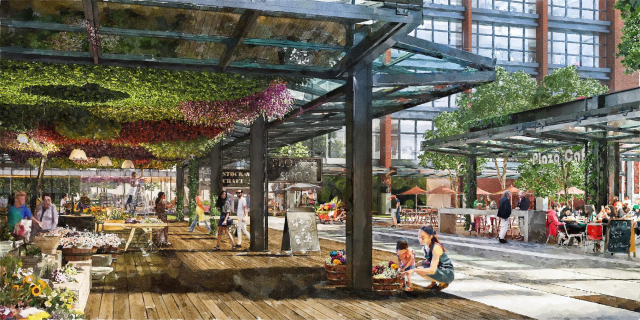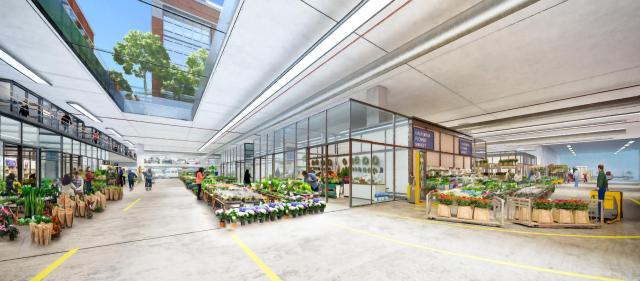
By Zelda Bronstein
DECEMBER 19, 2014 — In the face of continuing opposition, Kilroy Realty Corporation has completed its takeover of the San Francisco Flower Mart.
But the future of the development deal and the legendary market is still very much up in the air.
In September, a majority of the stockholders of the San Francisco Flower Growers Association agreed to sell their portion of the market’s Sixth and Brannan site to Kilroy.
That deal is currently under litigation by a dissident shareholder, while in October a coalition supporting the flower vendors announced that it was preparing to place a measure on the November 2015 ballot that would preserve the current zoning and thereby prohibit Kilroy’s proposed high-rise development at the site.
At a Wednesday morning press conference, representatives of a second property owner, the California Flower Market, joined Kilroy Senior Vice President Mike Grisso to announce that their shareholders had approved a “partnership” with the giant L.A.-based real estate investment trust: Kilroy will buy their part of the site, and CFM will operate a new, “state-of-the art” flower market that will occupy 125,000 square feet of the high-rise office project—115,000 square feet of wholesale/warehouse space underground and 10,000 sf of retail at ground level.
CFM President Steve Oku said that Kilroy had guaranteed “no rent increases” to flower vendors for five years, and beyond that, the option to renew for 25 years. “We will have the cheapest rents for PDR [Production, Distribution, and Repair] in the city,” he declared. The new facility is tentatively scheduled for completion in 2018. A leaflet in the press packet states:
Temporary relocation [of the vendors] either on or off site may be necessary; however it is our goal to keep all tenants onsite throughout construction. We will discuss pros and cons of each option with tenants before any decision is made. Kilroy Realty will pay all costs associated with relocation, including moving tenants back into the new facility.
To hear Oku tell it, CFM “negotiated hard” not only with Kilroy but with the city. “The city came to us” and said “we don’t want to be accused of building a bridge to nowhere”—a reference to the Central Subway. That project is being touted by the Planning Department as the rationale for the huge upzoning envisioned in the draft Central SoMa Plan: to pencil out, mass transit needs mass patronage.
The Flower Mart sits at the edge of the Plan area, which extends from Second to Sixth Streets. Oku said that the city originally “told us we have to move” to make way for high-density commercial and residential development. CFM pushed back, arguing that the Flower Mart needed to stay put, albeit in a modernized facility. It was “our idea” to “go underground” and “make a showcase there.”
When I asked CFM Executive Vice President Bob Otsuka to confirm Oku’s account, he told me that his colleague’s remark about “a bridge to nowhere” was “a rhetorical comment,” and that the city has always wanted the Flower Mart to stay in its current location.
At the Planning Department’s Central SoMa Plan open house, held on November 18, Otsuka said that he and his colleagues were worried that the cut flowers would be damaged by ethylene, the gas emitted by cars in the garage that’s proposed to go underneath the office tower. CFM would prefer parking to go aboveground. At the press conference, Oku told me that it was the city, not the developer, that wants the garage to go beneath the project. The underground parking, he said, will be “sealed off.”
That’s not what’s shown in the artist’s rendering of the underground flower market that was on display at the press conference.

In the back of the drawing, you can make out two levels of parking that appear to open directly onto the wholesale space.
Of course, at this stage of a project, an artist’s drawing is likely to have scant relationship to what actually gets built. Indeed, a note on a leaflet in the press packet says: “The renderings shown here are preliminary and subject to change based on continued input from all involved parties; detailed site plans will be available upon request.” At the press conference, I asked if the public could view the plans. The answer was no, because at this point the whole complex remains to be designed.
The feel-good tone of the press conference was punctured by a query from Examiner reporter Jonah Owen Lamb, who asked Grisso to comment on the ethics complaint that Oakland florist Melanie Tom filed against him on December 9 with the San Francisco Ethics Commission. Tom charges that Grisso, who formerly worked for the San Francisco Redevelopment Agency has violated city and state laws that govern lobbying and city employees’ financial conflicts of interests. “Will your actions with Kilroy, such as writing press releases for the mayor,” said Lamb, “show that Kilroy is not acting honestly?”
Grisso shrugged off the issue. “I don’t think there’s anything improper about that,” he said. “I’m confident that the Ethics Commission will review [the complaint] and dismiss it.”
On December 11, Grisso told me that he was unaware of Tom’s complaint. Before the press conference proper began, I asked him if since then he’d gotten any information from the San Francisco Ethics Commission. He said that, in accordance with their procedures, agency staffers had refused to tell him anything. But given that he also said that he’d read the 48 hills story about the complaint, which quotes extensively from Tom’s document, by now he should have a pretty good idea of her charges.
What really spoiled the celebratory atmosphere was the barrage of questions and allegations directed at CFM and Kilroy former Board of Supervisor President Aaron Peskin, who’s leading a coalition opposed to Kilroy’s plans. Peskin accused the partnership of offering the vendors “empty promises,” not written guarantees. For starters, he pointed out that the vendors’ current leases expire at the end of December, but they have yet to see the vaunted new five-year leases. The press packet leaflet says that “all tenants will receive new leases at the existing rent and terms by Dec. 5, 2014.”
Peskin also claimed that most of the vendors do not want to be below ground.
Stating that he’s “hopeful that there will be real, meaningful negotiations” between the flower sellers and Kilroy/CFM, Peskin warned that absent such discussion, on January 2 his coalition will start collecting signatures to place their initiative on the ballot. He noted that 78% of the 400 likely city voters surveyed in September by pollster David Binder wanted to see the market stay in its current location—a figure that makes him optimistic that the measure will qualify for the ballot and pass.
The potential for a ballot measure got a boost yesterday when John Elberling, director of TODCO, sent out a proposal calling for a clearly defined negotiation process that would make sure vendors get a fair deal. Just to be sure Kilroy doesn’t try to take advantage of the situation, he said, the Yerba Buena Neighborhood Consortium has donated $12,500 to the Save San Francisco Flower Mart group to begin collecting signatures.
That, Elberling said, would “empower the merchants for upcoming negotiations” and protect their status if negotiations fail.



